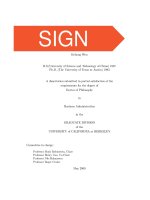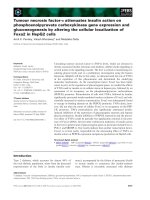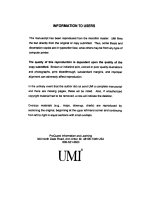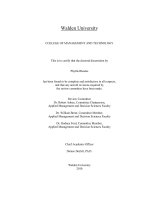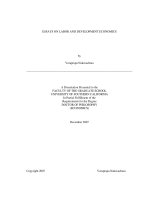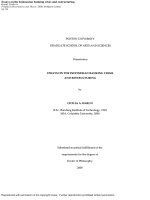Essays on factor shares, development accounting, and factor-eliminating technical change
Bạn đang xem bản rút gọn của tài liệu. Xem và tải ngay bản đầy đủ của tài liệu tại đây (2.02 MB, 176 trang )
ABSTRACT
STURGILL, BRADLEY SCOTT. Essays on Factor Shares, Development Accounting, and
Factor-Eliminating Technical Change. (Under the direction of John J. Seater.)
The stability of factor shares has long been considered one of the “stylized facts” of
macroeconomics. However, the relationship between cross-country factor shares and
economic development is dependent on how factor shares are measured. Most factor share
studies acknowledge only two factors of production: total capital and total labor. The failure
to acknowledge more than two factors yields misleading results. In the first essay I
disentangle physical capital’s share from natural capital’s share and human capital’s share
from unskilled labor’s share. Results reveal that non-reproducible factor shares decrease
with the stage of economic development, and reproducible factor shares increase with the
stage of economic development. This suggests that studies relying on the macroeconomic
paradigm of constant factor shares should be revisited.
Development accounting nearly always assumes the constancy of factor shares. In
the second essay I perform the development accounting exercise but allow factor shares to
vary and distinguish between reproducible and non-reproducible factors. My approach yields
results that stand in stark contrast to those previously attained. The general consensus is that
at least half of the cross-country variation in output per worker accrues to the Total Factor
Productivity (TFP) residual. With my approach, the majority of variation in output per
worker accrues to factor shares, specifically physical capital’s share and natural capital’s
share. Depending on the approach used to compute factor shares, TFP’s explanatory power
decreases by as much as 61 percentage points. This evidence does not, however, diminish
the role of technical change. Rather, the evidence indicates the importance of acknowledging
a new type of technical change, one that impacts factor shares.
Peretto and Seater (2009) develop a theory of factor eliminating technical progress
that predicts a systematic relationship between factor shares and output per worker. The first
essay verifies this systematic variation, and the second essay revisits one of many
macroeconomic exercises that assume such variation does not exist: the estimation of the
TFP residual. In the third essay, I extend the Peretto and Seater model by incorporating
endogenous saving. Endogenous saving alters the model so that the possibility of a Solow
Steady state is eliminated. All equilibrium paths lead to a production function that
asymptotically becomes AK.
Essays on Factor Shares, Development Accounting, and Factor-Eliminating Technical
Change
by
Bradley S. Sturgill
A dissertation submitted to the Graduate Faculty of
North Carolina State University
in partial fulfillment of the
requirements for the Degree of
Doctor of Philosophy
Economics
Raleigh, North Carolina
2010
APPROVED BY:
John J. Seater
Chair of Advisory Committee
John S. Lapp
Asli Leblebicioğlu Pietro F. Peretto
UMI Number: 3425931
All rights reserved
INFORMATION T
O ALL USERS
The quality of this reproduction is dependent upon the quality of the copy submitted.
In the unlikely event that the author did not send a complete manuscript
and there are missing pages, these will be noted. Also, if material had to be removed,
a note will indicate the deletion.
UMI 3425931
Copyright 2
010
by ProQuest LLC.
All rights reserved. This edition of the work is protected against
unauthorized copying under Title 17, United States Code.
ProQuest LLC
789 East Eisenhower Parkway
P.O. Box 1346
Ann Arbor, MI 48106-1346
ii
DEDICATION
To my parents
iii
BIOGRAPHY
Bradley Scott Sturgill was born in Winston-Salem, North Carolina on May 31, 1981
to Tony and Karon Sturgill. Brad grew up in Walnut Cove, North Carolina and attended
South Stokes High School. He earned a bachelors degree in Economics at Appalachian State
University in 2003. After finishing his undergraduate studies, he immediately began
pursuing his graduate degree at North Carolina State University. Brad served as a graduate
instructor and taught introductory economics at NCSU for three years. He completed the
final two years of his graduate work while teaching full time as a Visiting Instructor in the
Economics Department at Appalachian State University. Brad will continue his academic
career as an Assistant Professor in the Economics Department at Grand Valley State
University in Allendale, Michigan.
iv
ACKNOWLEDGEMENTS
I would first like to thank my family and close friends for their continuous support
and encouragement. Graduate school and the dissertation process was, in many ways, just as
tough and challenging for my parents, close friends and girlfriend as it was for me. There
were many holidays, phone conversations and weekend visits when I was in a less than
pleasant mood and consumed by my work. I am forever grateful for the patience and
understanding exhibited by the people that matter most in my life.
The degree to which my professional development has been positively impacted by
John Seater, the chair of my dissertation committee, is immeasurable. Writing under him has
been an honor, and I thank him for his supervision and guidance. My dissertation and
development as a researcher benefited greatly from comments and suggestions offered by
Pietro Peretto. I thank him for the passion and vigor he brought to the table, and I am
grateful for his willingness to serve on my committee. I thank committee members John
Lapp and Asli Leblebicioğlu for their comments and suggestions. I also thank participants in
the Triangle Dynamic Macro workshop at Duke University, especially Michelle Connolly.
Finally I would like to acknowledge the support and advice offered by a special group of
friends: thanks to Alex, Casey, Kristin and Jake.
v
TABLE OF CONTENTS
LIST OF TABLES vii
LIST OF FIGURES viii
Chapter 1 The Relationship between Cross-Country Factor Shares and the Stage of
Economic Development
1.1 Introduction 1
1.2 Motivation and Related Literature 3
1.2.1 Theoretical Background 3
1.2.2 Empirical Background 5
1.3 Decomposition of Total Capital’s Share 10
1.3.1 Total Capital’s Share, OSPUE Adjustment 11
1.3.2 Physical Capital’s Share, OSPUE Adjustment 16
1.3.3 Natural Capital’s Share, OSPUE Adjustment 19
1.3.4 Total Capital’s Share, Labor Force Correction 19
1.3.5 Physical and Natural Capital’s Share, Labor Force Correction 22
1.3.6 Total Capital’s Share, No Adjustment for Self-employed Income 22
1.3.7 Physical and Natural Capital’s Share, No Adjustment for Self-employed
Income 26
1.4 Decomposition of Total Labor’s Share 26
1.4.1 Total Labor’s Share, OSPUE Adjustment 27
1.4.2 Unskilled Labor’s Share, Accounting for the Self-Employed 27
1.4.3 Human Capital’s Share, OSPUE Adjustment 30
1.4.4 Total Labor’s Share, Labor Force Correction 31
1.4.5 Unskilled Labor’s Share and Human Capital’s Share, Labor Force
Correction 32
1.4.6 Total Labor’s Share, No Adjustment for Self-employed Income 33
vi
1.4.7 Unskilled labor’s Share and Human Capital’s Share, No Adjustment for
Self-employed Income 34
1.5 Remarks 35
1.5.1 Key Departures and Contributions 35
1.5.2 Real GDP per Worker vs. Real GDP per Capita 38
1.5.3 The Treatment of Self-employed Income 39
1.5.4 Statistical Tests 40
1.6 Conclusion 41
Chapter 1 Tables and Figures 43
Chapter 2 Acknowledging Cross-Country Variability in Factor Shares: The
Implications for Development Accounting
2.1 Introduction 73
2.2 Implications for Development Accounting 75
2.2.1 The Production Function 75
2.2.2 The Impact on TFP Levels 76
2.2.3 Estimating the Variation in Output per Worker accruing to observables
and TFP 78
2.2.4 Relative Variance Estimates: Typical Assumptions 81
2.2.5 Relative Variance Estimates: Allowing Factor Shares to Vary 81
2.2.6 Relative Variance Estimates: Allowing Factor Shares to Vary and
Distinguishing between Human Capital and Unskilled Labor 86
2.2.7 Relative Variance Estimates: Including Natural Capital 87
2.2.8 Acknowledging a New Type of Technical Progress 89
2.3 Remarks 91
2.3.1 Alternative Production Functions 91
2.3.2 Additional Results 92
2.4 Conclusion 93
vii
Chapter 2 Tables 94
Chapter 3 Endogenous Saving in a Model of Factor-Eliminating Technical Change
3.1 Introduction 104
3.2 Factor Elimination with Endogenous Saving 105
3.2.1 Final Good Producers 106
3.2.2 Intermediate Good Producers 107
3.2.3 Households 113
3.2.4 General Equilibrium 115
3.3 Dynamic Analysis 118
3.3.1 Equilibrium Loci 119
3.3.2 Phase Diagrams 121
3.3.3 The Impact of
ρ
125
3.4 Conclusion 128
Chapter 3 Figures 130
3.5 Chapter 3 Appendix 143
3.5.1 The function
(
)
α
m 143
3.5.2 Household’s Necessary Conditions for Optimization 144
3.5.3 Arbitrage Locus 144
3.5.4 Stationarity Locus 147
3.5.5
0=C
&
Locus 149
3.5.6 Relative Position of
α
α
~
, and
∗
α
151
3.5.7 Intersection of Arbitrage Locus and
0=C
&
Locus 151
Figures for Chapter 3 Appendix 153
REFERENCES 157
viii
LIST OF TABLES
Table 1.1 Total Labor’s Share – Gollin’s Data 43
Table 1.2 Average Total Labor’s Share vs. Average Real GDP per Capita, 1980-1995
Bernanke and Gurkaynak Data 44
Table 1.3 Total Capital’s Share, 2000 (OSPUE Adjustment) 45
Table 1.4 Total Capital’s Share – OSPUE Adjustment 45
Table 1.5 Physical Capital’s Share, 2000 (OSPUE Adjustment) 46
Table 1.6 Natural Capital’s Share, 2000 (OSPUE Adjustment) 46
Table 1.7 Physical Capital’s Share and Natural Capital’s Share – OSPUE Adjustment 47
Table 1.8 Total Capital’s Share, 2000 (Labor Force Correction) 47
Table 1.9 Data Quality 48
Table 1.10 Total Capital’s Share – Labor Force Correction 49
Table 1.11 Physical Capital’s Share, 2000 (Labor Force Correction) 50
Table 1.12 Natural Capital’s Share, 2000 (Labor Force Correction) 50
Table 1.13 Physical Capital’s Share and Natural Capital’s Share – Labor Force
Correction 51
Table 1.14 Total Capital’s Share, 2000 (No Adjustment) 52
Table 1.15 Total Capital’s Share – No Adjustment 53
Table 1.16 Physical Capital’s Share, 2000 (No Adjustment) 54
Table 1.17 Natural Capital’s Share, 2000 (No Adjustment) 55
Table 1.18 Physical Capital’s Share and Natural Capital’s Share – No Adjustment 56
Table 1.19 Total Labor’s Share, 2000 (OSPUE Adjustment) 56
Table 1.20 Total Labor’s Share – OSPUE Adjustment 57
Table 1.21 Unskilled Labor’s Share and Human Capital’s Share, 2000 (OSPUE
Adjustment) 57
Table 1.22 Unskilled Labor’s Share and Human Capital’s Share – OSPUE Adjustment 58
ix
Table 1.23 Total Labor’s Share, 2000 (Labor Force Correction) 58
Table 1.24 Total Labor’s Share – Labor Force Correction 59
Table 1.25 Human Capital’s Share, 2000 (Labor Force Correction) 60
Table 1.26 Human Capital’s Share – Labor Force Correction 60
Table 1.27 Total Labor’s Share, 2000 (No Adjustment) 61
Table 1.28 Total Labor’s Share – No Adjustment 62
Table 1.29 Unskilled Labor’s Share and Human Capital’s Share, 2000 (No Adjustment) 62
Table 1.30 Unskilled Labor’s Share and Human Capital’s Share – No Adjustment 63
Table 2.1 Decomposition of Output per Worker – OSPUE Adjustment
Factor Shares Constant; Labor Components Entangled; and Natural Capital
Omitted 94
Table 2.2 Decomposition of Output per Worker – OSPUE Adjustment
Factor Shares Vary; Labor Components Separated; and Natural Capital
Included 95
Table 2.3 Decomposition of Variation in Output per Worker – OSPUE Adjustment 96
Table 2.4 Decomposition of Output per Worker – Labor Force Correction
Factor Shares Vary; Labor Components Separated; and Natural Capital
Included 97
Table 2.5 Decomposition of Variation in Output per Worker – Labor Force Correction 98
Table 2.6 Decomposition of Output per Worker – No Adjustment
Factor Shares Constant; Labor Components Entangled; and Natural Capital
Omitted 99
Table 2.7 Decomposition of Output per Worker – No Adjustment
Factor Shares Vary; Labor Components Separated; and Natural Capital
Included 101
Table 2.8 Decomposition of Variation in Output per Worker – No Adjustment 103
x
LIST OF FIGURES
Figure 1.1 Average Total Labor’s Share; Bernanke and Gurkaynak Data 64
Figure 1.2 Total Capital’s Share vs. Real GDP per Worker; OSPUE Adjustment 64
Figure 1.3 Physical Capital’s Share vs. Real GDP per Worker; OSPUE Adjustment 65
Figure 1.4 Natural Capital’s Share vs. Real GDP per Worker; OSPUE Adjustment 65
Figure 1.5 Total Capital’s Share vs. Real GDP per Worker; Labor Force Correction 66
Figure 1.6 Physical Capital’s Share vs. Real GDP per Worker; Labor Force
Correction 66
Figure 1.7 Natural Capital’s Share vs. Real GDP per Worker; Labor Force
Correction 67
Figure 1.8 Total Capital’s Share vs. Real GDP per Worker; No Adjustment 67
Figure 1.9 Physical Capital’s Share vs. Real GDP per Worker; No Adjustment 68
Figure 1.10 Natural Capital’s Share vs. Real GDP per Worker; No Adjustment 68
Figure 1.11 Total Labor’s Share vs. Real GDP per Worker; OSPUE Adjustment 69
Figure 1.12 Unskilled Labor’s Share vs. Real GDP per Worker; Adjusted for
Self-employed Labor 69
Figure 1.13 Human Capital’s Share vs. Real GDP per Worker; OSPUE Adjustment 70
Figure 1.14 Total Labor’s Share vs. Real GDP per Worker; Labor Force Correction 70
Figure 1.15 Human Capital’s Share vs. Real GDP per Worker; Labor Force
Correction 71
Figure 1.16 Total Labor’s Share vs. Real GDP per Worker; No Adjustment 71
Figure 1.17 Unskilled Labor’s Share vs. Real GDP per Worker; No Adjustment 72
Figure 1.18 Human Capital’s Share vs. Real GDP per Worker; No Adjustment 72
Figure 3.1.1 Phase Diagram;
0
=
C ,
(
)
δ
ε
ε
ρ
−
−
<<
1
0
A
130
xi
Figure 3.1.2 Phase Diagram;
ALC
<
<
0 ,
(
)
δ
ε
ε
ρ
−
−
<<
1
0
A
131
Figure 3.1.3 Phase Diagram;
ALC
=
,
(
)
δ
ε
ε
ρ
−
−
<<
1
0
A
132
Figure 3.1.4 Phase Diagram;
ALC > ,
(
)
δ
ε
ε
ρ
−
−
<<
1
0
A
133
Figure 3.1.5 Phase Diagram;
ALC >> ,
(
)
δ
ε
ε
ρ
−
−
<<
1
0
A
134
Figure 3.2.1 Phase Diagram;
0
=
C , 0
=
ρ
135
Figure 3.2.2 Phase Diagram;
ALC
<
<
0 , 0
=
ρ
136
Figure 3.2.3 Phase Diagram;
ALC
=
, 0
=
ρ
137
Figure 3.2.4 Phase Diagram;
ALC > , 0
=
ρ
138
Figure 3.3.1 Phase Diagram; 0
=
C ,
(
)
δ
ε
ε
ρ
−
−
=
1A
139
Figure 3.3.2 Phase Diagram;
ALC
<
<
0 ,
(
)
δ
ε
ε
ρ
−
−
=
1A
140
Figure 3.3.3 Phase Diagram;
ALC
=
,
(
)
δ
ε
ε
ρ
−
−
=
1A
141
Figure 3.3.4 Phase Diagram;
ALC > ,
(
)
δ
ε
ε
ρ
−
−
=
1A
142
Figure 3.4.1 Arbitrage Locus 153
Figure 3.5.1 Stationarity Locus, C = 0 154
Figure 3.5.2 Stationarity Locus,
ALC
<
<
0 154
Figure 3.5.3 Stationarity Locus,
ALC
=
155
Figure 3.5.4 Stationarity Locus,
ALC > 155
xii
Figure 3.6.1
K
rr <
α
branch of 0=C
&
Locus 156
Figure 3.6.2
K
rr >
α
branch of
0=C
&
Locus 156
1
Chapter 1
The Relationship between Cross-Country
Factor Shares and the Stage of Economic
Development
1.1 Introduction
Capital shares and labor shares are typically treated as constant parameters. For
example, Hall and Jones (1999), in an investigation of the role of productivity in explaining
cross-country differences in output per worker, assume that capital shares and labor shares
are constant across countries and equal to 1/3 and 2/3 respectively. Some studies, such as
Gollin (2002), present empirical evidence in support of constant factor shares across
countries. Others, such as Zuleta (2008a), conclude that factor shares vary across countries.
Despite conflicting empirical evidence and despite the doubts about the constancy of factor
shares expressed by Keynes (1939) and Solow (1958), most researchers accept Kaldor’s
(1961) submission that factor shares are constant as a “stylized fact” of macroeconomics.
Factor shares are not constant when factors of production are properly defined and
measured. The key step is making a distinction between reproducible factors and non-
reproducible factors. In most factor share studies, only two factors of production, capital and
labor, are acknowledged. Failure to acknowledge more than two factors yields results and
conclusions that are misleading at best. When discussing capital, economists generally refer
to physical or human capital—physical capital being tools, machinery, and structures, and
human capital encompassing education, health, and training. However, standard capital
2
share measures include the fractions of income paid to physical capital as well as natural
capital, which encompasses all natural resources including land, minerals, and oil. Physical
capital and natural capital are two distinct factors. Physical capital is reproducible, meaning
it can be accumulated, whereas natural capital is non-reproducible and can not be
accumulated.
1
Therefore, any claim about the standard capital share and how it relates to the
stage of economic development is really a claim about two separate factor shares and their
collective relationship with the stage of economic development. Likewise, standard
measures of labor’s share entangle the fraction of income paid to human capital, a
reproducible factor, and unskilled labor, a non-reproducible factor.
In this first chapter, I disentangle physical capital’s share from natural capital’s share
and human capital’s share from unskilled labor’s share. Though recent empirical work has
made progress in this area, my measurement techniques represent a clear departure from the
literature, and I provide a more complete and comprehensive analysis of the relationship
between factor shares and the stage of economic development. There is strong evidence that
non-reproducible factor shares decrease with the stage of economic development, and
reproducible factor shares increase with the stage of economic development. This finding
has theoretical and empirical implications. First, it provides support for theoretical growth
models, such as those presented by Peretto and Seater (2008) and Zuleta (2008b), that
incorporate factor eliminating technical progress. Secondly, it suggests that any theoretical
or empirical study relying on Kaldor’s claim that factor shares are constant should be
revisited.
The remainder of the chapter is organized as follows. Section 1.2 provides the
theoretical and empirical backdrop for my analysis. In Section 1.3, I disentangle physical
capital’s share from natural capital’s share and formally analyze the cross-country
relationship between output per worker and each factor share. I disentangle human capital’s
share from unskilled labor’s share in Section 1.4 and perform a similar cross-country
1
Non-reproducible factors are those factors with which an economy is endowed. Reproducible factors have to
be produced.
3
analysis. I make some comments and discuss the departure of my paper from the related
literature in Section 1.5. Section 1.6 concludes.
1.2 Motivation and Related Literature
1.2.1 Theoretical Background
The work of Cobb and Douglas (1928) and Kaldor (1961) suggesting that factor
shares were constant created a paradigm in macroeconomics. However, new theories and a
general refinement in the way we think about factors and factor shares call into question the
precedent set forth by Cobb and Douglas and Kaldor. Recent work in endogenous growth
theory distinguishes between reproducible and non-reproducible factors and explores the idea
that technical change can alter factor shares. These theoretical advances yield specific
predictions about the systematic relationship between the stage of economic development
and both reproducible and non-reproducible factor shares across countries.
Perpetual growth requires that the marginal products of reproducible factors of
production be bounded away from zero (Jones and Manuelli, 1997). This means that the
non-reproducible factors must either be augmented or eliminated. Virtually all analyses
focus on augmentation. However, Peretto and Seater (2008) develop a theory of endogenous
growth that focuses on factor elimination. Factor intensities are allowed to change
endogenously via spending on R&D, and this serves as the catalyst for growth. As
economies advance, non-reproducible factors of production become less important, and
reproducible factors of production become more important. In other words, their theory
predicts that non-reproducible factor intensities should decrease with output per worker, and
reproducible factor intensities should increase with output per worker.
2
The Peretto and Seater theory allows for monopolistic competition in the intermediate
goods sector. As a result, firms earn excess profits, and payments to the factors of
production do not exhaust firm revenues. Consequently, factor intensities and factor shares,
2
The term “factor intensity” refers to the elasticity of output with respect to a factor of production.
4
though related, are not equivalent. However, to the extent that factor shares measured using
national income account data are reasonable estimates of factor intensities, the theory
suggests that non-reproducible factor shares should decrease with output per worker, and
reproducible factor shares should increase with output per worker.
A factor share is the portion of total income that is paid to a factor of production, and
factors of production are often separated into two broad categories: total capital and total
labor. Total capital generally encompasses physical capital and natural capital, and total
labor generally encompasses human capital and unskilled labor. That being said, total capital
and total labor are not the factors considered by Peretto and Seater. They consider
reproducible and non-reproducible factors. Reproducible factors include physical capital and
human capital, the former of which typically gets lumped in with total capital and the latter
with total labor. Non-reproducible factors include natural capital and unskilled labor, the
former of which typically gets lumped in with total capital and the latter with total labor. On
the surface, this may seem like a trivial difference in the allocation of inputs between
composite categories. However, the theory’s implications pertain specifically to the
relationship between an economy’s stage of economic development and non-reproducible
and reproducible factor shares. Therefore, any empirical evidence in support of or against a
correlation between output per worker and either total capital’s share or total labor’s share
neither validates nor nullifies the theory. The theory is silent on the relationship between an
economy’s stage of economic development and either total capital’s share or total labor’s
share.
In a related vein of the literature, Zuleta (2008b) develops an endogenous growth
model in which growth occurs via capital using and labor saving technological progress.
Like Peretto and Seater, Zuleta incorporates endogenous factor intensities. The key
differences between Zuleta’s model and that of Peretto and Seater are: Zuleta solves the
social planner problem whereas Peretto and Seater consider the market solution; the saving
rate is endogenous in Zuleta and exogenous in Peretto and Seater; and the cost of new
technologies is modeled differently in the two studies. However, from an empirical
5
standpoint, Zuleta’s model yields the same testable implications pertaining to factor shares,
namely that reproducible factor shares are positively related to the stage of economic
development, and non-reproducible factor shares are negatively related to the stage of
economic development.
3
Hansen and Prescott (2002), who build on Galor and Weil (2000), propose a model of
transition from a primitive to an advanced economy. In their model, advancements in the
stage of development, which occur via exogenous technical progress, are accompanied by
decreases in land’s share. Land, like other natural capital, is non-reproducible, so the
prediction of Hansen and Prescott’s model is consistent with the aforementioned theories that
suggest non-reproducible factor shares should fall with output per worker.
1.2.2 Empirical Background
The simplest labor share calculation is computed as the fraction of real GDP
attributed to employee compensation. Capital’s share is then computed as the residual,
⎟
⎠
⎞
⎜
⎝
⎛
−
GDP
onCompensatiEmployee
1 . It has been argued, most notably by Gollin (2002), that the
aforementioned method, which Gollin refers to as naïve, is misleading because published
numbers on employee compensation omit the income flowing to the self-employed.
Assuming that a portion of self-employed income represents labor income, the consequence
of this omission is estimation of labor’s share that is too low and estimation of capital’s share
that is too high, especially in developing countries where self-employment is prevalent.
Gollin’s Contribution Gollin adjusts for this omission by including the operating surplus of
private unincorporated enterprises (OSPUE) in the computation of labor’s share. The idea is
3
Boldrin and Levine (2002) and Zeira (1998, 2006) develop models similar to that of Zuleta. Technical
advancement occurs via substitution of capital for labor. Boldrin and Levine’s model predicts that labor’s share
should decrease with economic development. Zeira’s model, though it makes no explicit predictions about the
relationship between factor shares and economic development, predicts a positive correlation between the
capital to output ratio and economic development.
6
that most self-employed people do not operate incorporated enterprises, and, consequently,
capital income and labor income of the self-employed are encompassed by OSPUE. Gollin
allocates OSPUE to labor and capital using three different adjustments and concludes that
accounting for the income of the self-employed via OSPUE yields results indicative of stable
factor shares across countries.
Gollin arrives at his conclusion without performing any formal analysis to test for
correlation between either capital’s share or labor’s share and real GDP per capita. Instead,
the stability claim is based on the observation that the adjustments using OSPUE yield capital
shares that are clustered in a range from .15 to .40. Such a range, which represents almost a
three-fold difference, is nontrivial, especially in the context of empirical estimation of
production functions where factor shares often appear as exponents.
Of the 31 countries for which Gollin computes labor’s share, real GDP per capita is
available from version 6.2 of the Penn World Tables for 26 of them. Omitting Botswana,
which is an outlier in the data,
4
and then regressing Gollin’s adjusted labor shares on real
GDP per capita for the remaining 25 observations yields slope coefficients that, statistically,
are no different from zero. Thus, given Gollin’s approach, a more formal analysis reveals
there are no inconsistencies between his claim and his data, and indeed factor shares appear
to be constant across countries. Regression results are reported in columns 1 and 3 of Table
1.1.
Irrespective of these results and the importance of adjusting for self-employed
income, aspects of Gollin’s methodology are questionable. First, real GDP per worker, as
opposed to real GDP per capita, is a better measure of economic development and should be
4
Botswana’s labor share is the lowest among all countries regardless of the adjustment used by Gollin.
Specifically, the value is 0.368 and 0.341 for Adjustment 1 and Adjustment 2 respectively. Including
Botswana, the mean labor share for Adjustment 1 is 0.745, and the mean labor share for Adjustment 2 is 0.675.
The standard deviation is 0.110 and 0.107 for Adjustment 1and Adjustment 2 respectively. Omitting Botswana,
the mean increases to 0.758, and the standard deviation falls to 0.087 for Adjustment 1. For Adjustment 2, the
mean increases to 0.686 and the standard deviation falls to 0.089.
7
used when testing for systematic variation in factor shares across countries.
5
Secondly, the
data from Gollin’s paper used in the aforementioned regression analysis are not a true cross-
section because the year for which the 25 data points are observed is not constant across
countries. The year of observation ranges from 1977 to 1992.
Gollin also plots pooled cross-country and time series data. His conclusion is that the
scatter plots indicate no systematic variation in labor shares across countries. Again, he
provides no statistical proof for his claim, and though a lack of correlation seems obvious to
the naked eye, the presence of heteroskedasticity is also obvious. Gollin acknowledges that
the variance in factor shares is higher for the poorer countries than for the richer countries,
and he admits that data quality may be a problem. However, he quickly dismisses this
potential problem without mentioning its potential consequences. Heteroskedasticity yields
biased standard errors and creates a situation where t statistics are no longer t distributed.
Failure to control for heteroskedasticity could lead to incorrect conclusions about the
statistical significance of slope coefficients.
6
A thorough analysis should consider the
sensitivity of the results to heteroskedasticity before making conclusions about the nature of
the cross-country variation in factor shares.
Bernanke and Gurkaynak Extension Using the Gollin framework, and specifically
Gollin’s adjustment 2, Bernanke and Gurkaynak (2001) estimate average labor shares over
the period 1980-1995. They increase the number of countries for which labor shares can be
calculated by constructing an imputed OSPUE measure. This measure is substituted in place
of actual OSPUE for countries that report only total operating surplus and do not distinguish
between the surplus of corporate enterprises and private unincorporated enterprises. In
5
I regressed Gollin’s adjusted labor shares on real GDP per worker instead of real GDP per capita, and the
qualitative results are unchanged. See columns 2 and 4 in Table 1.1. Thus, in this specific case, the results are
not dependent on how the stage of economic development is measured. The relationship between real GDP per
capita and real GDP per worker is considered in detail in Section 1.5 of the paper, and more detail as to why
real GDP per worker is a more appropriate measure is given.
6
Dawson et al. (2001) analyze data quality induced heteroskedasticity, and their findings suggest that the issue
is not just a technicality that should be addressed in order to simply comply with econometric theory; it is a
problem that, if not controlled for, can lead to incorrect interpretation of empirical results.
8
addition, when OSPUE can not be imputed, Bernanke and Gurkaynak compute average
labor’s share using what they refer to as the labor force correction. I discuss the imputed
OSPUE and labor force correction measures in detail later herein.
Bernanke and Gurkaynak “find no systematic tendency for country labor shares to
vary with real GDP per capita.” However, they reference no statistical tests in support of
their claim. They simply observe that most labor shares in their 54 country sample lie
between 0.60 and 0.80. In fact, Bernanke and Gurkaynak’s table 10, the table which reports
total labor shares, does not even include data on real GDP per capita.
Statistical evidence calls into question the validity of Bernanke and Gurkaynak’s
claim. I gathered data on real GDP per capita from version 6.2 of the Penn World Tables and
computed the average level of real GDP per capita over the period 1980-1995 for each
country in the Bernanke and Gurkaynak sample. A simple linear regression reveals a
positive and statistically significant relationship at the 1% level between the average labor
share reported in Bernanke and Gurkaynak’s table 10 and average real GDP per capita.
7
In
addition, the relationship remains statistically significant and positive after controlling for
heteroskedasticity using White corrected standard errors. Therefore, statistical evidence
indicates that Bernanke and Gurkaynak’s claim is unwarranted. Unless Bernanke and
Gurkaynak performed an unreported statistical analysis using a measure other than average
real GDP per capita, which would itself seem unwarranted given that the reported labor share
data is averaged, the claim directly conflicts with the data. A scatter plot is provided in
Figure 1.1
8
, and regression results are reported in Table 1.2.
9
7
I also ran the same regression substituting average real GDP per worker for average real GDP per capita.
Average labor’s share is positively and significantly correlated with average real GDP per worker at the 1%
level, and the point estimates change very little as can be seen in Table 1.2.
8
The International Organization for Standardization’s (ISO) three-letter country codes are used as data markers
in all plots.
9
For the plot and the regression analysis, I used the labor shares computed with “Actual OSPUE” wherever
possible. These numbers are reported in column 4 of Bernanke and Gurkaynak’s Table 10. When “Actual
OSPUE” was not available for a country, I used the labor shares computed with imputed OSPUE, which are
reported in column 5 of Bernanke and Gurkaynak’s Table 10. When imputed OSPUE was not available for a
country, I used the labor shares computed via the labor force correction, which are reported in column 6 of
Bernanke and Gurkaynak’s Table 10 under the heading “LF.”
9
An Argument for Attributing all Self-Employed Income to Capital Though the argument
for allocating self-employed income to labor and capital is sound, an argument in support of
the naïve measure also has merit. The naïve measure attributes all self-employed income to
capital. This is reasonable only if one acknowledges a self-employed person as a unit of
capital. Such acknowledgement may seem unwarranted at first pass, and it is likely that the
reader’s main objection to categorizing a self-employed person as a unit of capital is the
physical distinction between physical capital and labor. After all, a self-employed individual,
just like an employee, is indeed a person, and the contribution to production comes from the
human body. Physical capital on the other hand encompasses machines, buildings, tools,
etc., and these things are inanimate, durable inputs that must be produced. Such sentiments
arise from the typical textbook definitions of labor and capital. However, this paper focuses
on measuring the fractions of income that get paid to the inputs used in production. From an
income allocation perspective, a self-employed person is very similar to a unit of physical
capital.
The crucial question is whether self-employed income comes from a residual or from
a commitment. That is, does a self-employed person’s income come from the funds left over
after all expenses have been paid, or, does the self-employed person make a commitment to
pay himself a wage? Employers make a commitment to pay employees a wage, and to the
extent that employers want to retain employees, they take on risk because the commitment is
legally binding irrespective of the firm’s revenue. If a self-employed person makes a
commitment to pay himself a wage, there is no net risk nor is there a potential net gain or net
loss, because the individual is betting against himself. Therefore, the self-employed person
has no incentive to make a commitment to pay himself a wage. Such a commitment is not
going to result in a larger amount of income because the commitment can only be kept if
revenue less expenses exceeds the wage, and revenue less expenses belongs to the self-
employed person anyway. Regardless of any commitment to oneself, the amount of income
a self-employed person brings in is a residual. Therefore, it can be argued that self-employed
10
income should be treated as residual income and categorized as operating surplus just as
residual income in the corporate sector. Operating surplus, which is defined as “the excess of
value added over the sum of compensation of employees, consumption of fixed capital, and
net indirect taxes” by the United Nations Yearbook of National Account Statistics, is
considered part of capital compensation.
Gollin reports naïve labor share estimates in his table 2 along side his adjusted labor
share estimates. A simple linear regression reveals that the naïve measure is positively and
significantly related to real GDP per capita. A statistically significant positive relationship is
also present when the analysis is performed using real GDP per worker instead of real GDP
per capita. The regression results are reported in columns 5 and 6 of Table 1.1.
The absence of a systematic relationship between factor shares and the stage of
economic development is a result that rests on an adjustment to the commonly used
calculation that reflects a more detailed treatment of the data. However, the underlying
premise for the self-employment adjustment is questionable, and thus the aforementioned
analyses are incomplete at best.
1.3 Decomposition of Total Capital’s Share
The key omission in the aforementioned empirical studies is acknowledgement of
more than two factors of production. When Gollin performs his analysis and concludes that
factor shares do not systematically vary with real GDP per capita, the driving force of his
result is the adjustment made for the income of the self-employed. Bernanke and
Gurkaynak’s results emanate from the same adjustment. Regardless of the validity of this
adjustment, using the standard measures of capital and labor to study the empirical
relationship between factor shares and economic development is misleading if one fails to
acknowledge the composite nature of the factors. Standard accounting lumps non-
reproducible and reproducible factors together in composite categories. Specifically,
capital’s share encompasses the share of income paid to both physical capital and natural
capital, and labor’s share encompasses the share of income paid to both unskilled labor and
